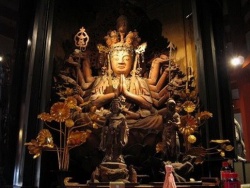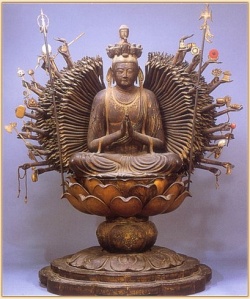Mantrayana -- Quotes From The Dalai Lama
Mantrayana S. Vehicle of Awareness Spells. also known as Vajrayana or 'Diamond Vehicle', symbolizing indestructibility. The Mantrayana had its origin in small groups of practitioners gathered around an accomplished master or guru.
The path based on teachings of the Tantras, known as the Mantrayana, emphasizes the practice of sadhana, the development and completion stages of meditation, and the skillful use of a great many transformational techniques.
It is elaborately structured in stages: preliminary practices, study of commentaries, formal initations, and receiving profound oral instructions. The skillful means are taught to fulfill the vision of the Bodhisattva and accelerate the process of awakening.
Because of the use of certain sacred syllables or mantras it is referred to as the Mantrayana. From the perspective of the Mantrayana, fully awakened reality abides primordially and intrinsically.
This is nature of the ground, our spiritual potential, as pervasive as the sky.
It is also the path that brings about recognition and removal of the clouds of emotions and ignorance. It is necessary to receive an empowerment from a lineage holder to practice the secret Mantrayana.
There are numerous mantras and skillful means available which have been empowered by the lineage gurus' wisdom to enable practitioners to move beyond emotional reactivity and be released into the all-encompassing primordial awareness.
Vajradhara is the super-human Teacher of the Secret Doctrine upon which the Vajrayana and Mantrayana are based. Asanga founded the Yogacara or contemplative School which developed into the Mantrayana or 'Path of the Mantra' about A.D. 700.
The Mantrayana, as a path kept secret to protect it from misuse, is not devulged to people outside the path. However, the qualifications for entering the Mantrayana and some of its salient points are openly discussed, such as in "Kalachakra Tantra -- Rite of Initiation" by the Dalai Lama and [[Wikipedia:|]]Jeffrey Hopkins. Below, I excerpt and comment on a few quotes of the Dalai Lama, with his words in RED, first about the value of practicing mantra.
The distinctive feature of the Secret Mantra Vehicle comes in terms of additional techniques for quickly developing the meditative stabilization that is a union of calm abiding samatha and special insight vipasyana --one-pointed meditative stabilization samadhi realizing emptiness shunyata . This mainly is achieved through diety yoga. . . . Secret Mantra is a case of using imagination as the path.
Then he makes this astonishing statement one page later: To become fully enlightened as a Buddha, it is necessary to practice Mantra and, within Mantra, Highest Yoga Mantra; otherwise it is not possible to attain Buddhahood. Some explanation follows before he reiterates: Therefore, without depending in general on Mantra and in particular on Highest Yoga Mantra, Buddhahood cannot be attained.
But the efficacy of mantra will only work for those who have the necessary qualifications, the proper motivation, the prerequisite understanding (dukkha, anitya, anatman), and the energy to carry through the practice (the generation of inner heat called tum-mo). Here are the Dalai Lama's words:
The first step is for the students to adjust their motivation so that it is properly qualified. Most of you know the importance of kindness -- the special kind of altruism, called bodhicitta in Sanskrit -- and of wisdom, called prajna. The most important factor is good motivation. With this human body already attained, to do something meaningful, you should not be selfish but should generate as much as possible an altruistic attitude. Altruism is most important.
The purpose is to serve other people, to help other beings, not just humans but all sentient beings, to bring about their welfare. The means to accomplish this is your own Buddhahood. This sequence of thoughts [omitted here] is how you come to determine that you must attain Buddhahood for the sake of others. The attitude generated is called bodhicitta, the altruistic intention to become enlightened, and it must be cultivated continually.
"Coninually" would mean to practice on a daily basis, at the least. Making Buddhism a part-time endeavor in one's life would definitely be beneficial, but cannot bring about full enlightenment. Next, the Dalai Lama invites students to enter the Mantrayana, without being distracted by the wonderful things of cyclic existence, and he tells them about two mistaken motivations for practicing Mantra. They are mistaken in the sense that the person's desire is for his own welfare. One is the motivation of seeking the happiness of this life, such as entering a mandala in order to prevent disease or to achieve success in a certain venture. The other mistaken motivation motivation is to practice mantra for the accunulation of merit for the purpose of seeking a future lifetime of high status within cyclic existence. Proper motivation is explained in the root text: "The intelligent should seek to enter the mandala with many acts of faith, seeking the aim of what transcends the world. They should not wish for effects in this life. Those wanting this life do not accrue the aim of what transcends the world. Those generating a seeking for what transcends the world gain expansive fruits even in this world. </poem>"

